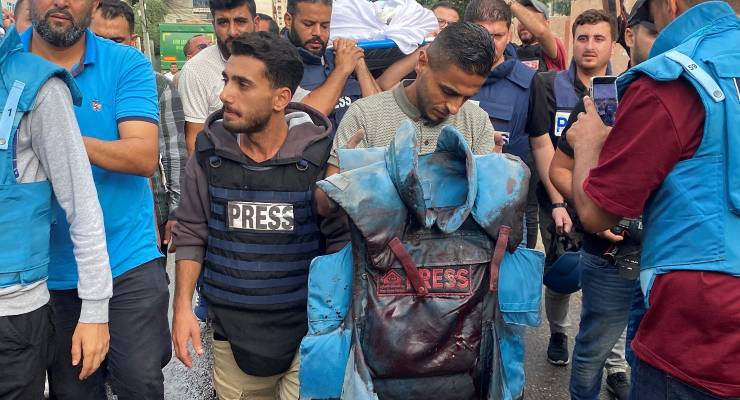
Every time someone criticises the news media for their coverage of the ongoing crisis in the Middle East, I counter with the number of journalists who have died since October 7.
At the time of writing on Monday, October 29, there have been 29 journalists reportedly killed doing their job, spanning 24 Palestinian, four Israeli and one Lebanese reporter. Eight journalists have been reported injured, and nine have been reported missing or detained.
Journalists are trying to tell the story of what’s going on right now. But it’s not only a life-limiting job; it’s also fraught with difficulty thanks to a deluge of misinformation on social media, amplified at times by time-poor journalists and those who have vested interests in either side of the dispute. Just one misplaced word or unverified claim can send supporters on either side into a fury, sparking violence in areas and countries far away from the Gaza Strip. The “Hamas” frame or the “Israeli” frame encourages or influences either side.
One of the reasons we really need Australian journalists on the ground is because we generally sign up to a view that journalists should be impartial, and in the Middle East that is not always the way. Palestinian journalists will say they are Palestinian first; Israelis will say they are Israeli first.
That was particularly clear when Vanity Fair reported on a series of internal Slack messages from The New York Times‘ #israel-briefings channel, which showed that a junior reporter on the ground and the paper’s international editor had their views dismissed by senior editors. They had been urging the paper to slow down the coverage, to be less certain, and to wait until there was verification from more than one source.
Anyone who has studied journalism knows the importance of verification, and also of the power of words so easily embedded with value judgments. One person’s terrorist is another one’s freedom fighter. But they are also laden with risks that may not be immediately obvious.
But it’s not just poor word choice and unverified information that get in the way of balanced reporting from in and outside of Gaza. It’s also hard for younger journalists to understand what’s going on without having done a history or other liberal arts degree, or having read Robert Fisk, or having had a very experienced subeditor explain it to them if there’s time.
It’s easy to suggest who is “right” and who is “wrong” if you don’t know, for example, some rules of war — or international humanitarian law — that can help navigate such conflicts.
Journalists from Australia are, generally, not experts in covering wars, and for that I am grateful. However, the hollowing out of senior staff from newsrooms, and a prior lack of history education, means that many don’t know that the justice or injustice of a cause of war does not change the obligation to follow humanitarian law. Civilians are entitled to be protected and cannot be disproportionately harmed by armies trying to achieve legitimate military goals.
Even in this piece, I’ve carefully used the descriptor of Middle East, because using words like justice and injustice when talking about Israel and Palestine comes loaded with meaning and can be easily misinterpreted.
All of us know this has never been an easy crisis to report on. The viewing public generally seeks a frame of the “good guys” and the “bad guys” — as do some newsrooms, unfortunately. But 24/7 news cycles, particularly on news and digital channels with inexperienced junior staff, do not have much room for more nuanced understandings or explanations.
Some of the worst reporting has come from TV news channels trying to feed the 24-hour news beast. It’s one of the reasons I now almost always prefer a curated nightly TV news coverage to rolling coverage is that it contains, mostly, fact-checked, more considered reporting. Reporters don’t always get it right, but at least giving journalists a few hours to pull a story together stops some of the most glaring reporting mistakes.
There is also an increasing information divide between those who can afford good information and those who cannot, a divide only increasing with time, making stories like this so much more difficult to understand. The fact that even normally reputable news outlets like The New York Times are struggling to get it right shows just how hard it is.
Audiences are already relying on “news” from unverified social media posts, partisan media coverage, and free online news written by untrained, junior journalists who are starting to discover just how difficult the job is to report the truth, especially in a breaking news situation. It’s almost impossible to do the research required for excellent journalism, unless the reporter is on the ground, witnessing things and seeing things that will never be erased from their brains.
Well-trained journalists do the work that others won’t do. They run toward danger. They fact-check, they curate, they choose words carefully. They don’t always get it right, but they do a much better job than the cookers on social media. If you want to know what’s going on the Middle East, turn into a curated news program, and turn off X (Twitter), Parler and TikTok.
While words matter, words alone will not eliminate injustice. But more careful, considered reporting will help prevent the situation from worsening. Good journalists are trying hard to not make things any worse. The rest need to catch up.








Crikey encourages robust conversations on our website. However, we’re a small team, so sometimes we have to reluctantly turn comments off due to legal risk. Thanks for your understanding and in the meantime, have a read of our moderation guidelines.